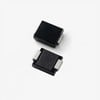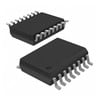Help with Single Phase Surge Suppressors specifications:
General Specifications
Back to Top
|
|
| ||
| Mounting | |||
| Your choices are... | |||
| Wall / Panel / Backboard Mount | Surge suppressors have bolting or mounting holes so that they can be attached to a wall or backboard. | ||
| Hard-Wired / Device Mount | Surge suppressors mount on or within the device that is to be protected from surges. | ||
| DIN Rail | Surge suppressors mount on a DIN rail. | ||
| In-Line / Integrally Attached | Surge suppressors are threaded, or are designed for integral attachment to conduits, cabling, etc. | ||
| Plug-in Module | Surge suppressors are modules that plug into an existing system or surge suppression device. | ||
| PCB Mount | Surge suppressors are wired or soldered onto printed circuit boards (PCBs). | ||
| Rack Mount Type | Surge suppressors are rack-mounted. | ||
| Other | Other unlisted mounting types. | ||
| Search Logic: | All products with ANY of the selected attributes will be returned as matches. Leaving all boxes unchecked will not limit the search criteria for this question; products with all attribute options will be returned as matches. | ||
| Technology | |||
| Your choices are... | |||
| MOV | Metal oxide varistors (MOV) have high energy capabilities, good reliability, and consistent performance. They also have a non-linear clamping curve and fatigue rapidly at higher amperage levels. | ||
| Silicon Avalanche Diode | Silicon avalanche diodes have high clamping voltages, but a limited power-handling capacity that is destroyed easily by the power levels encountered in typical power-line surges. Silicon avalanche diodes are used most often in data-line protectors and on circuit boards as static protectors. | ||
| Silicon Thyristor Diode | Silicon thyristor diodes are used mainly to protect telecom systems. | ||
| Gas Tube | Gas tubes have higher energy capabilities than either MOVs or diodes. They typically consist of two electrodes held at a close distance so that high voltages between the electrodes simply arc through the air to effectively clamp the voltage. Gas tubes are very slow, but can handle very large surges. | ||
| Hybrid | Hybrids attempt to incorporate all the major advantages of many of the individual components, while collectively overcoming their individual faults. | ||
| Other | Other less commonly used technologies include spark gaps, selenium, and Zener diodes. | ||
| Search Logic: | All products with ANY of the selected attributes will be returned as matches. Leaving all boxes unchecked will not limit the search criteria for this question; products with all attribute options will be returned as matches. | ||
Performance
Back to Top
|
|
| ||
| Maximum Surge Current | Maximum surge current is the maximum current allowed for a single impulse waveform with a continuous voltage applied. This value indicates the protection capacity of a particular surge suppressor design, and is used in specifying a product for a given application. A higher-level surge current capacity is required for a high-exposure application where there are very large transients present from lightning. | ||
| Search Logic: | User may specify either, both, or neither of the "At Least" and "No More Than" values. Products returned as matches will meet all specified criteria. | ||
| AC Energy Absorption | AC energy absorption measures a surge suppressor's ability to absorb heat energy created by transient surges. Note that the Joule rating is not a part of IEEE or UL standards. | ||
| Search Logic: | User may specify either, both, or neither of the "At Least" and "No More Than" values. Products returned as matches will meet all specified criteria. | ||
| Maximum AC Power | The maximum AC power that the device can handle. | ||
| Search Logic: | User may specify either, both, or neither of the "At Least" and "No More Than" values. Products returned as matches will meet all specified criteria. | ||
| Operating Temperature | The full required range of operating temperature. | ||
| Search Logic: | User may specify either, both, or neither of the limits in a "From - To" range; when both are specified, matching products will cover entire range. Products returned as matches will meet all specified criteria. | ||
Wires / Voltage
Back to Top
|
|
| ||
| Wires | |||
| Your choices are... | |||
| 2-Wire | The device has two wires plus ground. | ||
| 3-Wire | The device has three wires plus ground. | ||
| 4-Wire | The device has four wires plus ground. | ||
| Search Logic: | All products with ANY of the selected attributes will be returned as matches. Leaving all boxes unchecked will not limit the search criteria for this question; products with all attribute options will be returned as matches. | ||
| Voltage | |||
| Your choices are... | |||
| 120 | The device protects 120 VAC systems. | ||
| 208 | The device protects 208 VAC systems. | ||
| 220 | The device protects 220 VAC systems. | ||
| 240 | The device protects 240 VAC systems. | ||
| 277 | The device protects 277 VAC systems. | ||
| 346 | The device protects 346 VAC systems. | ||
| 380 | The device protects 380 VAC systems. | ||
| 480 | The device protects 480 VAC systems. | ||
| 600 | The device protects 600 VAC systems. | ||
| 120/240 | The device protects 120/240 VAC systems. | ||
| 120/208 | The device protects 120/208 VAC systems. | ||
| 220/380 | The device protects 220/380 VAC systems. | ||
| 240/480 | The device protects 240/480 VAC systems. | ||
| 277/480 | The device protects 277/480 VAC systems. | ||
| 347/600 | The device protects 347/600 VAC systems. | ||
| Other | Other unlisted voltages. | ||
| Search Logic: | All products with ANY of the selected attributes will be returned as matches. Leaving all boxes unchecked will not limit the search criteria for this question; products with all attribute options will be returned as matches. | ||
Standards and Features
Back to Top
|
|
| ||
| Standards | |||
| Your choices are... | |||
| UL 1449 Third Edition | UL 1449 Third Edition is a set of safety standards for surge protective devices (SPDs). The formal title of these standards is "ANSI/UL 1449 & UL Standards for Safety for Surge Protection Devices, UL 1449." | ||
| UL 1449 Second Edition | UL 1449 Second Edition standards apply to devices that are designed to limit repeated transient voltage surges. | ||
| UL 497A Rating | UL 497A is a specification for telephone surge suppressors. These requirements cover secondary protectors for use in single or multiple pair-type communications circuits, not cellular phones. | ||
| UL 497B Rating | UL 497B rating is a specification that covers telecommunication and fire alarm circuits. It protect circuits from surges generated by lightning, inductive switching, electrostatic discharges, and others. | ||
| UL 1459 Rating | UL 1459 covers telecommunications products such as telephone answering devices, residential telephone instruments, telephone dialers, cordless phones, key systems, and private branch exchange (PBX) equipment. These devices are designed to be electrically connected to a telecommunications network with an operating voltage to ground that does not exceed 200 V peak, 300 V peak-to-peak, and 150 V rms. | ||
| UL 452 Rating | UL 452 covers antenna-discharge units for radio and television receiving equipment, and amateur radio-transmitting and receiving equipment. | ||
| ANSI | The American National Standards Institute (ANSI) is the administrator and coordinator of the U.S. private-sector voluntary standardization system. ANSI includes nearly 1000 company, organization, government agency, institutional, and international members. | ||
CE Marking |
CE marking indicates that a product complies with the essential requirements of relevant European Union (EU) directives that uphold national standards for health, safety, and environmental protection. CE Marking is required in the countries of the European Economic Area (EEA), an organization that consists of the twenty five member states of the EU and the three members of the European Free Trade Association (EFTA). CE Marking refers to the safety of a product. It is not a quality standard. | ||
CSA Mark |
Products that bear a CSA Mark have been tested by the Canadian Standards Association (CSA) and meet applicable standards for safety and/or performance. These standards are written and administered by organizations such as the American National Standards Institute (ANSI), Underwriters Laboratories (UL), and CSA International. CSA Marks may appear alone or with indicators. CSA Marks that appear alone are used with products certified primarily for the Canadian market, to the applicable Canadian standards. CSA Marks that appear with the indicators “C” and “US” or “NRTL/C” is used with products certified for both the U.S. and Canadian markets, to the applicable U.S. and Canadian standards. | ||
| IEC | The International Electrotechnical Commission (IEC) is a global, non-profit organization that develops and maintains voluntary quality, safety, and performance standards for electrical materials, products, and systems. The IEC also publishes standards for the electronics and telecommunications industries. The IEC’s membership consists of the electrotechnical standards organizations from each of its 51 member nations. The American National Standards Institute (ANSI) represents the United States. | ||
| IEEE | Products are tested and/or certified according to standards or guidelines from the Institute of Electrical and Electronics Engineers (IEEE). | ||
| UL | Underwriters Laboratories (UL) is a non-profit organization that tests components, systems, and materials according to its published standards for safety. Products that receive UL approval bear a UL Mark. | ||
| RoHS Compliant | Restriction of Hazardous Substances (RoHS) is a European Union (EU) directive that requires all manufacturers of electronic and electrical equipment sold in Europe to demonstrate that their products contain only minimal levels of the following hazardous substances: lead, mercury, cadmium, hexavalent chromium, and polybrominated biphenyl and polybrominated diphenyl ether. RoHS will become effective on July 1, 2006. | ||
| WEEE Compliant | Waste Electrical and Electronics Equipment (WEEE) is a European Union (EU) directive designed to encourage the reuse, recycling and recovery of electrical and electronic equipment. WEEE is also designed to improve the environmental impact and performance of this equipment. The WEEE directive establishes requirements and criteria for the collection, treatment, recycling and recovery of electrical and electronic equipment. It also makes producers responsible for financing these activities. Retailers and distributors must provide a way for consumers to return used or obsolete equipment without charge. | ||
| Other | Other unlisted standards. | ||
| Search Logic: | All products with ANY of the selected attributes will be returned as matches. Leaving all boxes unchecked will not limit the search criteria for this question; products with all attribute options will be returned as matches. | ||
| Features | |||
| Your choices are... | |||
| AC Adapter Spacing | The device's electrical outlets are spaced in a way that allows multiple AC adapters to be plugged in as well. | ||
| Audible Alarm | The panel contains an audible, surge-activated alarm. | ||
| Complete Pin Protection | All pins are protected. | ||
| Continuously Live Outputs | The device has dedicated continuously-powered outlets that permit the flow of power regardless of the surge suppressor's ON/OFF status. | ||
| Graphical Display | The device has a liquid crystal display (LCD) or other graphical interface that provides information about power or fault conditions. | ||
| Grounding Wire | A drop cable is used to connect to verified ground. | ||
| Hospital Grade | Underwriters Laboratories (UL) approves and recognizes the device as hospital grade. These surge suppressors must pass additional safety tests that measure leakage current. | ||
| Integral Disconnect | This feature is designed to protect personnel during maintenance activities. | ||
| NEMA Enclosure | The device is contained within a NEMA enclosure. These enclosures are rated by the National Electrical Manufacturers Association (NEMA) and designed for hazardous or non-hazardous locations and indoor or outdoor use. | ||
| NC/NO Dry Contacts | The device has NC/NO dry switch contacts. | ||
| On / Off Switch | The device has a toggle switch for turning the unit ON or OFF. Consult the manufacturer for information about whether surge protection is active when the device is OFF. | ||
| Resettable Circuit Breaker | The device trips an internal breaker for protection against power surges. After corrective action is taken, the surge suppressor can be reset. | ||
| Remote Alarm Contacts | Remote alarm contacts can be used as switches to provide remote-status indication of device performance and status. | ||
| Self-Diagnostics | The device performs self-tests to ensure the integrity of diagnostic components. | ||
| Sine Wave Tracking | Surges are attenuated and dissipated as part of a normal-power sine wave. | ||
| Surge Counter | Surge counters record the number of surges suppressed. | ||
| Thermal Fusing | Thermal fuses are safety devices that are activated in the event of an extended over voltage. They take the device power off-line. | ||
| Visual Indicators / LEDs | Devices have light emitting diodes (LEDs) or other visual indicators so that operators can determine if the unit is ON, grounded, etc. | ||
| Search Logic: | All products with ANY of the selected attributes will be returned as matches. Leaving all boxes unchecked will not limit the search criteria for this question; products with all attribute options will be returned as matches. | ||


